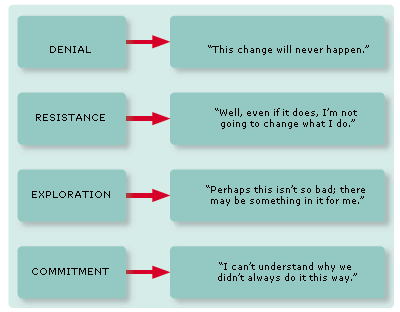Overcome Resistance to Change
Recognize that people go through four stages, starting out wary of change and finishing up welcoming it.

People get very used to a set way of doing things and do not welcome being asked to behave differently. Good leaders will overcome this resistance, persuading people to accept that nothing stays the same forever.
Communicate Change
While some people will embrace change, most people approach it with a certain amount of caution. The key to overcoming this natural resistance is to involve people in the forthcoming change as early as possible. Explain that there are going to be some changes; but ask for their opinion and look for feedback. You are dealing with experienced people who will probably have valuable insights into the best way to operate. If, for example, you are responsible for installing new checkouts in a supermarket, you will court disaster if you don’t involve checkout operators at an early stage. If you leave it until the terminals are installed, you are unlikely to achieve your objectives. Ask for a number of representative checkout operators to look at the new equipment at an early stage in the project and give their opinions of it.
Use Agents of Change
The biggest influence you can bring to bear to overcome resistance is the peer group. You will find key opinion leaders in every part of an organization, so when you plan for overcoming resistance to change, look for these people and make sure that they are firmly on board and supportive of the change you are introducing. They are your agents of change. Get them to be part of the pilot study so that they can advocate the change from a position of knowledge and experience. Include them in your communications plan so that they can take up their role of persuading people that the project is a good idea, not only for the organization but for them.
Think Smart
Do not discount the role of personal motivating factors. When people are looking at the possibility of change they are not thinking, “What is in it for the organization?” but “What is in it for me?” (WIIFM).
While people work for the benefit of the organization, they live for themselves and they will be better motivated if they feel that they are also producing a result for themselves. Whenever you make a presentation or discuss your project with other people, make sure that you are answering the WIIFM question, whether they ask it openly or not.
Tip
If at least 20 per cent of the people who need to change are themselves agents of change the process of change will probably go quite smoothly.
